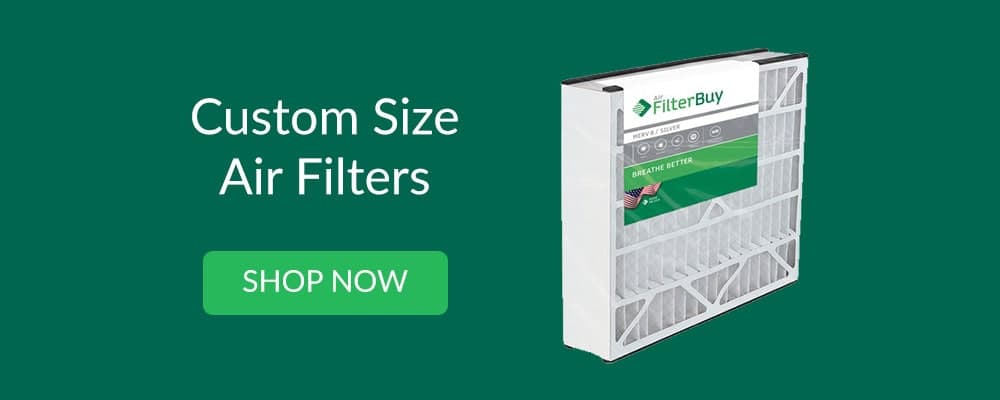Shop by
![Conquer Asthma Triggers in Your Home: The Power of Air Filters [A Guide to MERV]](/_next/image/?url=https%3A%2F%2Fs3.amazonaws.com%2Fairfilterbuy-content-service%2Fa2be03conquer-asthma-triggers-at-home.png&w=3840&q=75)
Struggling to breathe comfortably at home due to asthma? You're not alone. Air filters can be a game-changer in your fight for easier breathing.
Yes, medication and lifestyle changes are crucial for asthma management. But air filters offer a natural and budget-friendly way to reduce asthma triggers lurking in your home.
This guide will equip you to choose the perfect MERV air filter for conquering asthma. We'll break down the science of filtration, explore different filter types, and help you find the one that transforms your home into a haven for easier breathing.
Remember: Consult your doctor for a personalized asthma plan that may include medication and lifestyle adjustments alongside air filtration.
Are you struggling to breathe comfortably in your home because of asthma? You're not alone.
Millions of people grapple with asthma symptoms like chest tightness, coughing, and shortness of breath.
While medication and lifestyle changes are crucial for managing asthma, air filters can be a powerful weapon in your fight for easier breathing. Let’s find out why air quality matters in asthma.
According to a report from the Centers for Disease Control and Prevention (CDC), asthma is a widespread health concern, affecting 1 in 13 people in the United States [2]. That translates to 25.7 million Americans, including a staggering 7.0 million children younger than 18. This translates to a significant health and economic burden on patients, families, and society [2].
Here are some key statistics highlighting the prevalence of asthma in the United States (data from the CDC):
The World Health Organization (WHO) estimates that the global burden of asthma is even greater, with an estimated 235 million people currently living with the condition [2].

Healthy air is critical for people with asthma. Unlike the occasional cold, exposure to pollutants and allergens can trigger asthma attacks, leading to wheezing, coughing, and difficulty breathing.
This is why both indoor and outdoor air quality plays a significant role in asthma management.
Indoor Allergens: Microscopic troublemakers love to hide in your home and can trigger asthma symptoms when inhaled. Here are some culprits:
Dust mites: Thrive in carpets, bedding, and upholstered furniture.
Pet dander: Shed by cats, dogs, and other furry friends.
Mold spores: Grow in damp areas like bathrooms and basements.
Indoor Irritants: Harsh chemicals and everyday products can irritate your airways, causing asthma-like symptoms. Be mindful of these:
Strong cleaning chemicals: Opt for natural cleaning solutions whenever possible.
Smoke: Avoid secondhand smoke and be cautious when burning candles or fireplaces.
Volatile organic compounds (VOCs): Emitted from new furniture, paint, and some building materials. Choose low-VOC options when possible.
Outdoor Air Quality: Don't forget about the impact of outdoor air on your asthma and empower yourself with information to keep your asthma under control.
Smoke and smog: Air pollution can trigger asthma attacks, so be mindful of local air quality reports. Use a tool like Air Now to know what your local air quality is before you go outside.
Pollen: Seasonal pollen counts can significantly impact asthma symptoms. Plan outdoor activities accordingly. Use a tool like Pollen.com to find out what the pollen count is like in your area.
While outdoor air quality can be unpredictable and filled with asthma triggers like pollen and smog, you have the power to create a safe haven inside your home. By taking control of your indoor environment, you can significantly reduce these triggers and breathe easier. Here's how:
Maintaining a Clean Home: Regular vacuuming with a HEPA filter, frequent dusting, and washing bedding in hot water can significantly reduce dust mites and allergens.
Controlling Humidity: Mold thrives in humid environments. Aim for a humidity level between 30% and 50% with a dehumidifier if necessary.
Improving Ventilation: Proper ventilation allows fresh air to circulate and removes indoor pollutants. Open windows when air quality permits and use exhaust fans in bathrooms and kitchens.
Using Air Filters: MERV-rated air filters capture airborne particles like dust mites, pet dander, and mold spores, reducing their presence in your breathing space.
By understanding the role of indoor air quality and taking these steps, you can create a healthier breathing environment and manage your asthma more effectively.
READ MORE: 10 Ways to Improve Indoor Air Quality
Yes! Air filters act like tiny bodyguards, guarding against dust, pollen, and other irritants that aggravate your lungs. HEPA filters, the superstars of air filtration, can trap a whopping 99.97% of particles as small as 0.3 microns – that's way smaller than the width of a human hair! Studies have shown that HEPA sleep zone air purifiers targeting the area where you breathe while sleeping can be particularly beneficial for improving allergy symptoms [1].
Every home needs HVAC filters to keep dust, dirt, and debris from clogging your heating and cooling system. But why not upgrade your filter to do double duty?
MERV-rated air filters are a popular and effective choice for asthma sufferers, offering a step up from standard air filters. MERV stands for Minimum Efficiency Reporting Value. This rating system indicates how effectively an air filter traps particles on a scale of 1 to 16, with higher numbers capturing a greater percentage of smaller particles.
Here's why MERV filters are a great option for asthma management:
Target the Culprits: Asthma is triggered by airborne particles like dust mites (size: 10-30 microns), pet dander (size: 10-50 microns), and pollen (size: 10-100 microns) [3]. MERV filters, particularly those with a rating of 11 or higher, can capture between 50% and 85% of these irritants, significantly reducing their presence in your breathing space [3].
Cost-Effective Solution: Compared to HEPA filters, which can trap a whopping 99.97% of particles as small as 0.3 microns, MERV filters offer a balance of affordability and effectiveness for asthma control. While HEPA filters capture the most minuscule particles, they can be more expensive. MERV filters provide a targeted approach to trapping asthma triggers at a more accessible price point.
READ MORE: All about MERV ratings

The vast market of air filters can be overwhelming, but here are some key factors to consider when choosing a MERV filter for asthma management:
MERV Rating: As mentioned earlier, aim for a MERV rating of 11 or higher for optimal asthma control.
Filter Size: Ensure the filter fits your HVAC system for proper airflow and performance.
Change Frequency: Replace your MERV filter regularly as recommended by the manufacturer, typically every 2-3 months, to maintain its efficiency.

Don’t forget to consult your doctor to create a personalized asthma management plan that includes medication and lifestyle changes in addition to air filtration.
MERV air filters can be a powerful tool in your fight for easier breathing. By combining MERV filtration with other asthma management strategies, you can take control of your asthma and create a healthier, happier home environment.
The recommended frequency for changing your air filter depends on several factors, such as pet dander levels and household occupancy, but generally falls every 2-3 months. If you have pets or allergies, you may need to change them more frequently.
Yes, getting your HVAC serviced regularly can significantly improve your indoor air quality and benefit your asthma management.
Generally, maintaining good air quality through filters is a cost-effective approach to asthma management. While the cost of air filters varies depending on size and quality, they typically range from $10 to $50 and need replacing every 2-3 months. This makes them a relatively affordable approach compared to medications, inhalers, and potential emergency room visits. So, from a cost perspective, air filters offer a way to improve indoor air quality and potentially reduce reliance on other asthma management methods.
Air filters are a great first line of defense, but to truly create a haven for your lungs, consider a multi-pronged approach. You can significantly reduce asthma triggers by:
Minimizing Allergens: Encase pillows and mattresses in encasements to reduce dust mites, wash bedding frequently in hot water, and remove clutter where dust mites can hide. If you have pets, consider having pet-free zones in your home.
Controlling Humidity: Mold thrives in humid environments. To discourage mold growth, aim for a humidity level between 30% and 50%.
Identifying and Avoiding Triggers: Work with your doctor to identify your asthma triggers and take steps to minimize exposure. Common triggers include dust mites, pet dander, pollen, smoke, and strong cleaning products.
Maintaining a Clean Environment: Regular cleaning with a HEPA vacuum and damp cloths helps remove dust mites, pet dander, and other allergens from your home's surfaces.
Improving Ventilation: Proper ventilation allows fresh air to circulate and reduces indoor air pollutants. Open windows when air quality permits and consider using exhaust fans in bathrooms and kitchens.
By following these tips and incorporating HEPA and MERV air filters into your asthma management plan, you can create a cleaner, healthier breathing environment and breathe easier at home.
First and foremost, keeping your house clean helps lessen the amount of dust mites and pet dander that can cause asthma episodes. Furthermore, using air purifiers might aid in removing allergens from the surrounding air. Additionally, it's critical to abstain from indoor smoking since it might result in poor air quality, which is a major asthma trigger. When pollen counts are high, windows should be kept closed to prevent pollen from entering the home.
Try your best to be cool and sit up straight. Next, take your rescue inhaler as directed by your physician. It is important to get medical attention right away if your symptoms worsen even after using the inhaler. Refrain from forcing yourself to breathe deeply or reclining down since these activities may make the condition worse.
Breathing in through your nose and out through your mouth is a helpful method. You can reduce your breathing rate and avoid the risk of hyperventilation by engaging in this technique. Another technique is "pursed-lip breathing," which is inhaling through the nose and exhaling slowly through lips that are tightly pursed. Above all, it's important to keep your cool because panic can exacerbate asthma symptoms.
Deep breathing exercises, yoga, meditation, and other relaxation practices can help you achieve this. Stress levels can be greatly reduced with the use of these techniques. Furthermore, if you're experiencing chronic stress, you must get expert assistance as this can aid with your symptoms and provide you with helpful coping mechanisms. Regular exercise also helps lower stress levels since it improves general well-being and helps control asthma brought on by stress.
Dust mites, mold, pet dander, and cockroaches are examples of indoor allergens that may be the cause of your worsening asthma at home. It's possible that specific cleaning supplies or scents are causing you to react. Attempt to recognize and get rid of these triggers.
Quick-acting bronchodilator inhalers are a common source of immediate relief for asthma sufferers, helping to widen their airways and facilitate better breathing.
Steam inhalation is not advised for people with asthma since it can exacerbate symptoms by narrowing airways. Always get medical advice before beginning any new treatment.
Vicks is not advised for asthmatics since it may worsen airway inflammation and mucus production.
Try sitting up straight, pursed lips, or deep belly breathing if you need to open your lungs without using an inhaler. These, however, are only band-aid fixes and cannot take the place of medical care.
When an asthmatic has silent asthma, they do not experience the typical symptoms, such as coughing or wheezing. Alternatively, there could be a sudden decline in lung function, which could be rather harmful.
Due to its bronchodilator action, studies have shown that coffee can somewhat enhance lung function for up to four hours. It should not, however, be the main course of treatment for asthma. Always get medical advice before making changes to your asthma medication regimen.
Sources:
1. Can Air Filters Ease Asthma Symptoms?
2. Allergic and Environmentally Induced Asthma - StatPearls - NCBI Bookshelf
3. What is a MERV rating? | US EPA Effectiveness of Air Filters and Air Cleaners in Allergic Respiratory Diseases: A Review of the Recent Literature - PMC
4. Air Filter | Treatment | ACAAI Public Website
